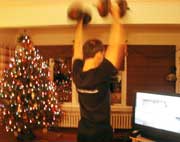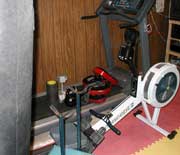Feature Article
No Place Like Home

While "there's no place like home for the holidays," for many people, working out at home is the holy grail of fitness.
The number one reason is obvious: convenience. But more than
that, some people may not be able to get to a gym or fitness studio regularly, especially those with kids. (Or cats. At least, our
cats.) Training at home also means not having to worry about getting access to the equipment you want, being ogled (or worse) by
the masses, getting icky germs, or having to listen to mind-numbingly awful music.

But there are some obvious pitfalls to working out at home, too. The most prominent is the Lure of the Couch: it's very easy to
get distracted into not working out at all. Maybe it's not the couch, but the kids, or the cats, or the stove, or that darn TV.
If you
go somewhere to work out, there's a really good chance you will. At home, not so much. A big part of
that is
accountability: when you're out, other people can see you slacking; when you're home, there's usually no one
ratcheting up the peer pressure.
Another potential pitfall is a lack of equipment. While there are plenty of ways to train with little or no equipment, having a
wide variety of weights and devices available can provide a more thorough and well-rounded training experience. (For examples of
equipment you can use at home, see parts
one,
two,
and
three of our holiday gift series.)
A couple of pitfalls also apply to training at the gym. First, what kind of workout should you do? If lifting weights, how
much, for how many sets and reps, with how much rest in between, in what order on what days, etc. For cardio, how long, how
fast, how often, etc. And should you be doing specific work for balance? Mobility? Core? The best answers to these questions
will come from a good personal trainer. Otherwise, you'll have to do some research to try to figure out what's best for yourself
(which isn't always easy, even for pros), or go with a generic plan from a book, DVD, or website.
And second, even if you know
what to do, are you sure you're doing it right? There's a very fine line between a plank position that works the core and one
that doesn't (or worse, stresses the lower back). The same applies to most movements. People with defective movement patterns
(i.e., pretty much everyone) won't change those patterns unless coached out of them.
So if you're determined (or resigned) to train at home, keep these points in mind:
- Have a plan and track your progress. This is the only way to know if what you're doing is really working.
- Get some equipment. It doesn't have to be much: a couple resistance bands and a kettlebell take up very little space yet
offer a wide variety of options.
- Get some support. A training buddy is ideal. Cats are not. You could also start posting your workouts (or at least
acknowledging them) on Facebook to get some social accountability.
- Stick with it. Consistency is king. Schedule your own workouts and stick to your schedule.
Also, remember the old saying: "You can't train your way out of a bad diet." Whether you're trying to lose fat,
pack on muscle, or both, you simply cannot do it without eating well. As with training, be sure to have a plan and plenty
of support and accountability.

Training at home can be an excellent way to improve your fitness, as long as you do it, and do it right. I do some of my own
training at home, where my "gym" includes a treadmill, rowing machine, heavy bag, speed bag, weight bench,
resistance bands, pull-up bar, dumbbells, kettlebells, Bosu, Swiss ball, cats, and Perry Mason DVDs. I also use
blitzometer.com (the StrongFast Fitness system) to schedule and track my training. But that's me. To be successful
training at home, you need to find what works for your goals, your schedule, your life. Now where have I heard that before?
Be seeing you.
-gary
PS If you'd like to do most of your training at home and get the help you need to be successful, check out the all new
StrongFast Blended Fitness!